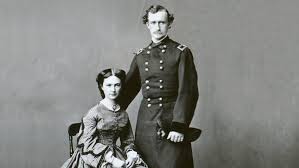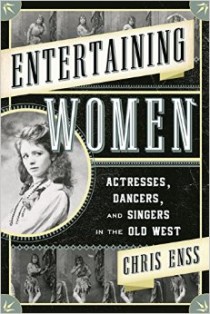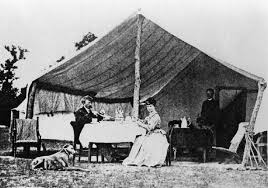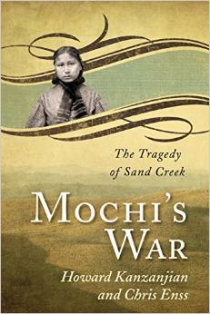1869-The Golden Spike was driven at Promontory Point, Utah signifying the completion of the transcontinental railroad even though there are no bridges spanning the Missouri River.
Courting Elizabeth
Don’t miss out. Enter to win a copy of
None Wounded, None Missing, All Dead: The Story of Elizabeth Bacon Custer.
A full moon hovered over South Monroe Street, and beams of light from the gigantic orb filtered through a cluster of clouds. Twenty-one-year-old George Armstrong Custer stumbled through the scene, helped along by a friend who steadied his walk and kept him from falling. Both men were dressed in the uniform of the 5th Cavalry, and both had been drinking. In fact, George was drunk. It was late, and apart from the two inebriated soldiers, the street was deserted.
It was the fall of 1861, and numerous leaves had dropped off the massive trees lining the thoroughfare, drifting across the path the men followed. George was making his way to his sister Ann Reed’s home, where he had been staying while recovering from a slight illness contracted after the Battle of Bull Run. George had carried dispatches to the Union troops holding their position against the Confederate Army lined along Bull Run Creek near a railroad center called Manassas Junction in Virginia. The battle had ended when the Union Army was ordered to fall back toward Washington, and the accompanying downpour of rain had left George suffering with chills and fever. He was sent back to Monroe to recuperate, and as George’s condition improved, he started venturing out to local taverns where his friends gathered.
Arm in arm with his school chum, an intoxicated George and his buddy staggered down the roadway, singing at the top of their lungs. The commotion woke his sister, who raced to the front window of her house, followed closely by her husband and children, to see who was disturbing the quiet, respectable neighborhood.
George was unaware that Judge Bacon, Elizabeth Bacon’s father had witnessed the scene. He also had no idea that Elizabeth herself had been gazing out of her upstairs bedroom window at the same moment. She wasn’t surprised at the sight, having seen other young men who’d had too much to drink. She considered his actions standard fare, and the following morning, barely remembered the spectacle George had made of himself the night before.
To learn more about Elizabeth Bacon Custer and how she lived to glorify her husband’s memory read None Wounded, None Missing, All Dead.
This Day…
On Stage in the Old West
Coming in October!
Entertaining Women: Actresses, Dancers, and Singers in the Old West.
This collection of short stories of the women who entertained the West in makeshift theaters and palaces built to showcase the divas who were beloved by emigrants to the “uncivilized” West will feature well-known and lesser known dancers, singers, and actresses and their exploits. Author Chris Enss will bring her comedic timing and long experience writing about the time and culture of the West to this collection.
On Stage in the Old West
Coming in October!
This collection of short stories of the women who entertained the West in makeshift theaters and palaces built to showcase the divas who were beloved by emigrants to the “uncivilized” West will feature well-known and lesser known dancers, singers, and actresses and their exploits. Author Chris Enss will bring her comedic timing and long experience writing about the time and culture of the West to this collection.
This Day…
Before George
Giveaway! Enter to win a copy of
None Wounded, None Missing, All Dead: The Story of Elizabeth Bacon Custer.
An exquisitely framed photograph of George Custer rested on an easel next to a lectern. Elizabeth Bacon Custer, George’s devoted wife, studied her husband’s image as she sat in the meeting hall at John Street Church in Lowell, Massachusetts, on January 31, 1894. Hundreds of flowers surrounded the enlarged picture-the last one taken of Custer, in late April 1876. Adorned in a blue uniform decorated with rows of brass buttons, medals, and intricately woven golden shoulder braids, he was the model of strength and confidence. His short hair was neatly combed, and his thick mustache was smoothed down over his lips.
The room was filled with ladies dressed in their finest Sunday clothes, sitting at numerous tables arrayed around the large hall. They were giddy with excitement and chatted briskly while sipping coffee and tea. Elizabeth’s seat was at a long table for ten placed upon a dais. She was the guest of honor, flanked on either side by overly attentive women continuously thanking her for being with them.
Within a few moments Elizabeth was introduced as the keynote speaker, and as she rose from her chair, radiant and poised, the entire room was galvanized into sudden and tumultuous applause. She stood in simple, dignified response to the ovation and smiled sweetly to her left, then to her right. After everyone had taken their seats. Elizabeth expressed her appreciation for the kind reception and then began her story.
“My husband was killed more than seventeen years ago at the Battle of the Little Bighorn,” she said in a crisp, cultured voice. “I believe he had many enemies there, and none of them were Indians. His rivals sent him on a suicide mission, with to few troops and ammunition.”
To learn more about Elizabeth Bacon Custer and how she lived to glorify her husband’s memory read None Wounded, None Missing, All Dead.
This Day…
The Controversial Custers
Giveaway! Enter to win a copy of
None Wounded, None Missing, All Dead: The Story of Elizabeth Bacon Custer.
One of the most charming and controversial soldiers the country ever produced, George Armstrong Custer and his equally delightful and charming bride were devoted to one another. They valued the time they spent together in the field and at their never-permanent homes at various army posts. Many times, Elizabeth lived in a tent alongside members of the 7th Cavalry.
Over the twelve years the Custers were together, Elizabeth had lived history. She and George had honeymooned in war zones during the waning years of the Civil War, and she had witnessed the surrender of Robert E. Lee at the Appomattox Court House. (She was later given the table at which the terms of surrender were signed.) Elizabeth embarked upon her frontier life following the Civil War, when George’s regiment was sent to Texas to facilitate Reconstruction, and later, to the Great Plains states as an “Indian fighter.” Her life was a series of thrilling adventures that lasted until the memorable day when Custer and his troops made their immortal last stand against the Sioux Indians.
To learn more about Elizabeth Bacon Custer and how she lived to glorify
her husband’s memory read
None Wounded, None Missing, All Dead.
Mochi’s War – Library Journal Review
Advance Review of Mochi’s War from Library Journal
Historian Enss and Kanzanjian (coauthors, None Wounded, None Missing, All Dead) succeed in personalizing one of America’s most troubling memories, the brutal and unprovoked massacre of a sleeping village of Cheyenne and Arapaho peoples at Sand Creek (present-day Colorado) by troops of the Colorado Volunteers in November 1864. This still controversial military engagement (see Ari Kelman’s A Misplaced Massacre) sets the background in which Mochi, a Cheyenne woman, lost her entire family and barely survived herself, by killing a soldier and then fleeing her camp. She reinvented herself as a Dog Soldier and member of the Bowstring Society, one of the few females to claim association in these elite Cheyenne warrior groups. She remarried, to Medicine Water, himself a military leader, and they in turn brutally raided and avenged themselves on American soldiers and settlers alike for over a decade. The authors have again collaborated to write Western history in an accurate yet accessible manner for mainstream readers. They provide a graphic account of the Plains Indian Wars from 1864 to 1875. VERDICT Highly recommended for adult readers of Western and Native American history, this biographical account provides a counterpoint to the many works that have mythologized such women as Pocahontas and Sacajawea .
—Nathan Bender, Albany Cty. P.L., Laramie, WY






